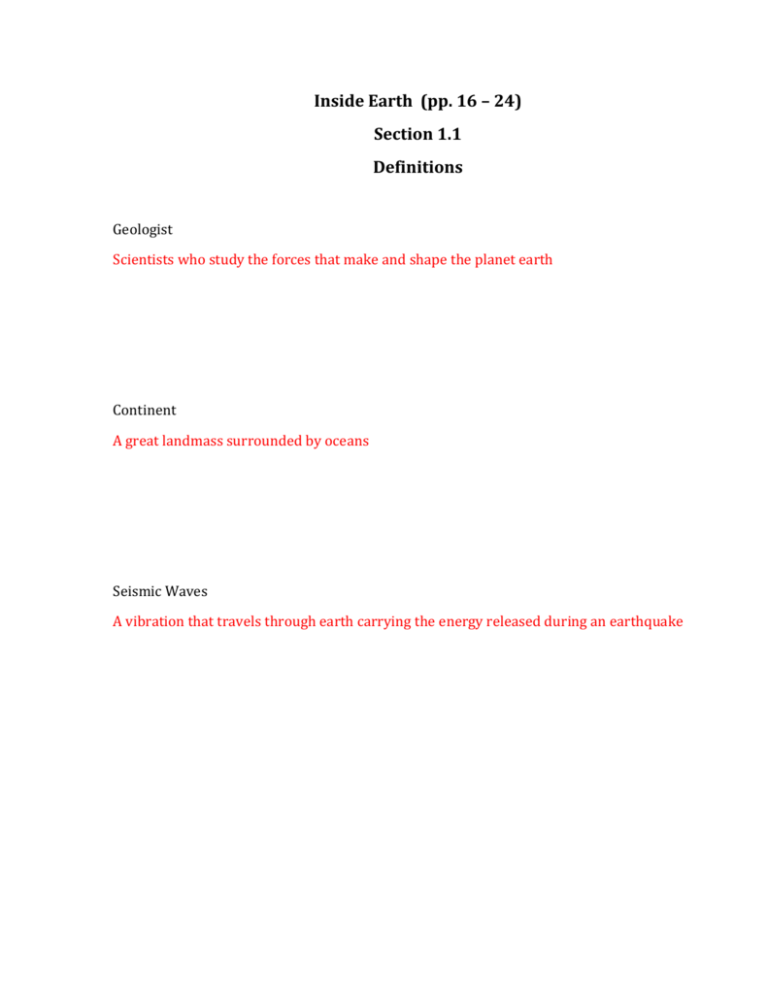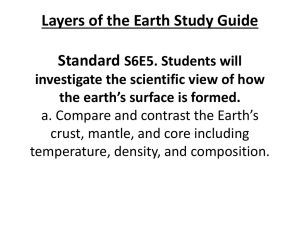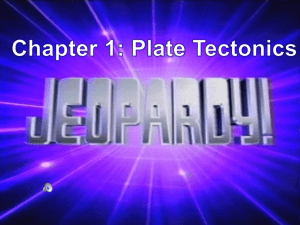Inside Earth (pp. 16 – 24)
advertisement

Inside Earth (pp. 16 – 24) Section 1.1 Definitions Geologist Scientists who study the forces that make and shape the planet earth Continent A great landmass surrounded by oceans Seismic Waves A vibration that travels through earth carrying the energy released during an earthquake Inside Earth (pp. 16 – 24) Section 1.1 This diagram represents the inside of the earth. Blue represents water and brown represents rock and soil. Crust Lithosphere Athenosphere A Word Bank Mantle Asthenosphere Lithosphere Outer Core Inner Core Outer Core Inner Core Mantle Crust Inside Earth (pp. 16 – 24) Section 1.1 Fill in the Blank 1. As you get closer to the center of the earth, the pressure _____increases___________________ and the temperature ______________________ increases_____________. 2. The three main layers of the earth’s interior are the __________crust_______, the _________mantle________, and the ___________core___________. 3. Ocean crust is most commonly composed of a rock called _____basalt______ whereas continental crust is most commonly composed of a rock called ____granite_______. 4. Ocean crust is ______thinner________________ (thicker or thinner) than continental crust. Matching Match the layer of the earth with the description. _______E____________ inner core A. thinnest earth layer ________B___________ outer core B. thick,extremely hot molten metal ________F_____________ mantle C. rigid layer of the mantle ________D____________ asthenosphere D. soft, slowly flowing layer of the mantle ________C____________ lithosphere E. solid metal ________A_____________ crust F. layer with the greatest volume, made out of hot rocks. Inside Earth (pp. 16 – 24) Section 1.1 Matching Match the chemicals with the layer of the earth in which it can be found. Several of the answers are used more than once. 1. Crust ___A, B, C, D, E, F, G, ________ 2. Mantle ___A, B, C, D_________________________ 3. Core _______C, H_____________________________ Discussion A. Oxygen B. Silicon C. Iron D. Magnesium E. Calcium F. Aluminum G. Potassium H. Nickel 1. What are two major differences between the continental crust and oceanic crust? Oceanic crust is mostly made of basalt. Continental crust is mostly made of granite. Oceanic crust is thinner than continental crust. Oceanic crust is denser than continental crust. 2. What happens in the earth’s interior to produce the earth’s magnetic field? Currents in the liquid outer core force the solid inner core to spin. The inner core spins faster than the rest of the planet. It is a solid iron/nickel ball spinning rapidly in the center of the earth. This movement causes the earth’s magnetic field. Inside Earth (pp. 25 – 27) Section 1.2 Definitions: Heat Transfer The movement of energy from a warmer object to a cooler object Radiation The transfer of energy through empty space Conduction Heat transfer by direct contact Convection Heat transfer by movement of a heated fluid Density A measure of how much mass there is in a volume of a substance Mass/volume g/mL Convection Current A flow that transfers heat within a fluid. Inside Earth (pp. 25 – 27) Section 1.2 This is a diagram of the mantle of the earth. Draw the convection currents that occur in the mantle. Be careful to draw them in the correct part of the mantle! (this illustration is found on page 27. Be careful that the arrows go the correct direction and that they are only found in the correct layer! The illustration only shows one side of the earth, but this illustration should be marked around the entire circle.) Inside Earth (pp. 25 – 27) Section 1.2 Matching (Each word has two or more choices that match.) ________B, D, G_____ radiation A. ice melting in your hand B. heat from the sun _______A, C, I_______ conduction C. touching a stove and getting burned D. the heat you feel from a campfire a few feet away ________E, F, H________ convection E. the mixing of air in the atmosphere caused by warm air rising and cool air falling. F. spaghetti boiling on the stove rises and falls in the pot Showing that there are currents in the water. G. the heat you feel when you put your hand a few inches away from a light bulb H. currents caused by the heating and cooling of the magma inside the earth. I. a spoon sitting in hot soup becomes hot. Discussion 1. What happens to the density of a fluid when it becomes hotter? What happens to the density of a fluid when it becomes cooler? When a fluid becomes hotter it becomes less dense. When a fluid becomes cooler it becomes more dense 2. What happens to convection currents when a fluid reaches constant temperature? When the fluid is a constant temperature convection currents stop. Inside Earth (pp. 28 – 32) Section 1.3 Definitions: Wegener’s hypothesis All the continents had once been joined together in a single land mass and have since drifted apart. Pangaea The name of the single landmass that broke apart and gave rise to today’s continents Continental Drift The hypothesis that the continents move across earth’s surface Fossil A trace of an ancient organism that has been preserved in rocks Inside Earth (pp. 28 – 32) Section 1.3 This is a map of the earth. Use the key to fill in the four major geologic evidences for continental drift. Draw each on the map, using the correct color. (copy from page 30) Folded mountains Glossopteris Fossils Glacial Deposits Coal beds Discussion: Glossopteris Fossils 1. What was the main reason scientists rejected Wegener’ hypothesis? He could not explain what caused the continents to move and separate. 2. How many years did it take for scientists to accept Wegener’s hypothesis? Could his hypothesis be rejected again? How? 50 years. Yes, if new evidence was discovered that showed his hypothesis to be incorrect it would be changed or rejected. Inside Earth (pp. 33 – 39) Section 1.4 Definitions: Mid-ocean ridge The longest chain of mountains in the world. It is found in the middle of the Atlantic ocean on the ocean floor. Sonar A device that bounces sound waves of under water objects and then records the echo of the sound waves Sea-floor spreading The process that continually adds new material to the ocean floor. Molten material rises from the mantle, erupts, spreads out, and pushes older material to the sides. The Glomar Challenger A drilling ship that gathered samples from the ocean floor that proved sea-floor spreading actually happens. Deep Ocean Trench A deep valley along the ocean floor through which oceanic crust slowly sinks towards the mantle. Subduction The process by which oceanic crust sinks beneath a deep-ocean trench and back into the mantle at a convergent plate boundary Inside Earth (pp. 33 – 39) Section 1.4 (see diagram page 36) 1. Use the key to color the diagram to illustrate the parts of the sea floor surrounding a mid ocean ridge. 2. Label the Oceanic Crust. 3. Label the Mid-Ocean Ridge Molten Material (Magma) Mantle olten Materialwhen (Magma) Rock formed the magnetic field was in the same direction as it is today Rock formed when the magnetic field was reversed. Inside Earth (pp. 33 – 39) Section 1.4 (page 34) 1. Draw the location of the Mid-Ocean Ridges. 2. Draw the location of the deep ocean Trenches. 3. Label the Mid -Atlantic Ridge (write the name next to the line) Fill in the blank When oceanic crust meets continental crust, the oceanic crust moves ________underneath______________ (underneath or above) the continental crust because the oceanic crust is _________more________________ (more or less) dense. Inside Earth (pp. 42 – 47) Section 1.5 Definitions Scientific Theory A well tested concepts that explains a wide range of observations Plate Tectonics The theory that pieces of earth’s lithosphere are in constant motion, driven by convection currents in the mantle Transform Boundary A plate boundary where two plates move past each other in opposite directions Divergent Boundary A plate boundary where two plates move away from each other Convergent Boundary A plate boundary where two plates move towards each other Rift Valley A deep valley that forms where two plates move apart Inside Earth (pp. 42 – 47) Section 1.5 (see pages 44 and 45) Draw a diagram to illustrate each answer. If you need more room, use additional paper or write on the back of this page. 1. When two oceanic plates diverge, what landform is created? Draw a diagram of this situation. 2. When two oceanic plates converge, what landforms are created? Draw a diagram of this situation. 3. When a continental plate and an oceanic plate converge, what landforms are created? Draw a diagram of this situation. 4. When two continental plates converge, what landforms are created? Draw a diagram of this situation. 5. When two continental plates diverge, what landforms are created? Draw a diagram of this situation.








